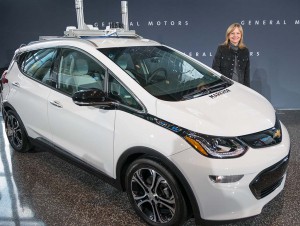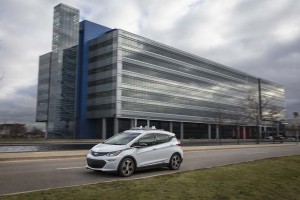
The Chevy Bolt will be General Motors first fully autonomous car when it brings a self-driver to the market in the future.
General Motors Co. is steadily ramping up its spending on autonomous vehicles, expecting to lay out $600 million this year alone on its self-driving vehicle efforts.
The total is four times what it spent last year, Chuck Stevens, GM chief financial officer, said during a recent presentation to financial automation.
Stevens said the GM’s effort is being led by Cruise Automation, which GM paid $1 billion for last year. GM also has moved to ensure that Cruise can maintain a start-up culture to meet the rapidly evolving move into automated driving,
GM, along with other traditional automakers such as Ford, Mercedes-Benz and Renault-Nissan, is now considered one of the leaders in self-driving vehicles. In fact, the automaker finished second behind the aforementioned Ford in a recent study by Navigant Research that ranked the makers on their leadership in the autonomous arena.
The company announced yesterday it plans to launch its first semi-autonomous system, the Cadillac Super Drive, in the 2018 Cadillac CT6. GM’s first fully self-driving car coming to market will be a version of the electric Chevrolet Bolt EV, Stevens re-iterated during his presentation.
(Caddy going hands-free in 2018 launch of Super Cruise. Click Herefor the story.)
Stevens also emphasized that Cruise is now a GM subsidiary that has been integrated into GM’s big-company structure so its engineers are free to operate separately and independently. It will also be a separate business unit long term and in the future could report its own earnings, he added.
Cruise’s CEO and co-founder, Kyle Vogt, has “full responsibility for the operational and financial performance of our autonomous vehicle business,” Stevens said.
Cruise Automation — has a budget and it has been given both short- and long-term financial targets, and it’s monitored “at the highest levels of the organization by Mary, Dan and myself on a very frequent basis,” he added.
(For more on the new Navigant study, Click Here.)
The support for Cruise’s research will reach roughly $150 million per quarter going forward in 2017, Stevens added. GM expects to spend about $150 million per quarter on its self-driving effort in 2017, compared to the $150 million GM spent on engineering and research in 2016, Stevens said.
The ramp up in GM’s spending underscores the growing importance that the development of self-driving vehicles. Last week, Anthony Foxx, the former Secretary of Transportation, said last week that automated vehicles could start showing up on some streets within five years.
The $600 million level could also could continue into 2018, Stevens said. The spending does not cover the capital costs of developing an all-new vehicle for self-driving, because GM is already producing the vehicle in question: It’s the Chevrolet Bolt EV.
(Waymo and Bosch team up to put driverless robo-cabs on the road by 2021. Click Here for more.)
Stevens also re-iterated that GM expects the first self-driving cars will be built for car-sharing and ride-hailing businesses, not for retail buyers.


Autonomous driving is the best thing for engineering employment since emission controls.